9/1/2022
The Biggest (U.S.) Show in Horticulture
Chris Beytes, Bill Calkins & Jennifer Zurko
Another Cultivate is “all over but the shoutin,” as Chris Beytes’ southern father-in-law used to say, and there’s nothin’ that would have us label the annual event anything less than top-notch. Solid attendance (back to pre-pandemic levels), everyone was in a good mood, plenty of new products on the trade show floor … perhaps a bit of rain that made it tricky to get across the street to the North Market for lunch was the only dampening factor.
Held Saturday through Tuesday, July 16-19 in Columbus, Ohio, Cultivate’22 featured 652 exhibitors and more than 140 educational sessions, plus four different tours on Saturday (greenhouse, nursery, retail and landscape operations) and some workshops, too.
Regarding attendance, when we met with the AmericanHort staff Sunday afternoon in an informal get-together, CEO Ken Fisher told us, “We are back to pre-pandemic numbers … it’s pretty strong.”
Trade shows often don’t give out actual attendance figures, but digging back through our coverage of Cultivates past revealed the figure 10,016 from 34 countries in 2017. We doubt attendance was that high this year, but regardless, it doesn’t really matter how many attended if the right people were walking the aisles and we saw many of the big names in attendance.
Also very important: our friends from Canada and Europe were back in attendance, helping bring back the global flavor of the event.
Keynote: Compared to 2019, Everybody Was Up in 2022!
Monday morning saw one of the educational highlights of Cultivate’22: the AmericanHort State of the Industry Address featuring President and CEO Ken Fisher, advocacy expert Craig Regelbrugge, and Dr. Charlie Hall, AmericanHort’s chief economist. Here are some bullet points:
• U.S. horticulture/floriculture is a $348 billion dollar industry, creating 2.32 million jobs.
• Consumer demand has been bolstered by $10 trillion in economic stimulus, but now that it’s been paid out and time has passed, other factors are impacting the market, including a supply chain halt, fear of recession, “re-pricing” due to supply chain and labor issues, and inflation.
• The pandemic helped people save $2.7 trillion, but today, savings levels are lower than 2019—a bad trend.
• 2022 retail IGC data (compared with 2021) shows that IGCs are down 5.5% in sales, down 12% in transactions, but up 8.3% in average sale (due to price increases).
• The current consumer spending outlook is at a 20-year low.
• 2021 was the pinnacle of sales for the horticulture industry: gross sales up 20%, average ticket up 4%, margins up 20%, customer count up 15% and grower sales up 18%.
• But net profit for growers, retailers and landscapers was very mixed (from -7% to +33%).
• 2022 was a different story: weather was unpredictable; spring came late; retailers bought very early and inventory was long; for the first time in years, many wholesale orders were canceled; at the box store level, quarter-over-quarter comps were very erratic.
• 2022 vs. 2021 numbers are showing 30% of growers had increased gross sales, but 30% had lower gross sales.
• We should compare 2022 to 2019. In this case, 100% of growers are UP, with 63% of growers up more than 25% over their 2019 levels.
What to do? “Don’t be like Peloton,” concluded Dr. Hall. Peloton was too bullish about the market for their product. They assumed demand would continue to boom after the pandemic, so they loaded up on inventory and spent way too much on marketing. When things slowed down, they were stuck without any working capital and their stock price plummeted. Be very careful investing your working capital into inventory. Don’t bet the farm on what is very much a short-term trend.
The trade show floor held no shortage of new products for growing, automating and managing your business. Here are some of our favorites:
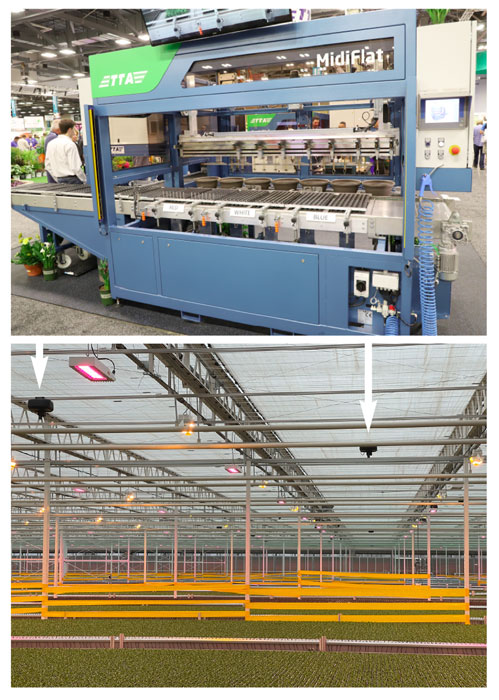
MultiColor Transplanter
TTA’s Midi MultiColor transplanter is designed for planting mixed baskets or pots with up to six different colors or varieties of plants. As shown, it’s equipped with 16 grippers with an output of up to 1,000 plugs per hour per gripper. At about $250,000 it’s not inexpensive, but have you tried finding people that want to stick plugs in baskets all day? tta.eu
AI Scouting in the Greenhouse
Established in 2013, newer company IUNU (pronounced like “you knew”) had their Luna AI moving camera on display for the first time at Cultivate. IUNU’s Trevor Hudson said it’s like “Google maps for your greenhouse.” The camera (the black devices in the photo) moves up and down the bays, zooming in to check on your crop to see if there are any issues. You can scout for insects, diseases, nutritional problems, leaf or bloom count—anything without having to walk up and down the aisles or moving benches around. A QR code that’s placed throughout the benches helps Luna find a specific area and it’ll send the images to your smartphone or tablet. It saves on time and labor that would be used for regular scouting and it can connect to your climate control system. iunu.com
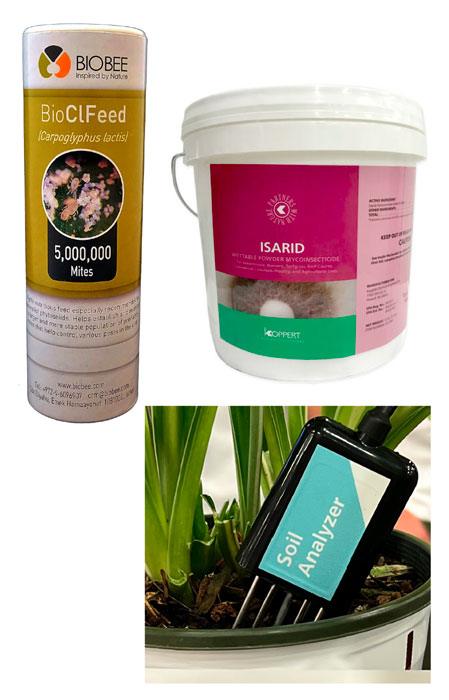
Parasitic Wasp Balls
BIOBEE introduced new systems for delivering nematodes, wasps and predatory mites, as well as just about every other predator used in greenhouse biocontrol. Because predators need supplemental food, too, the Israeli biocontrols experts released BioClFeed. It’s made of dried fruit mite, as well as sawdust, vermiculite and a dietary supplement, creating an alternative food source for at least six common predatory mites. This helps establish and maintain larger populations in your greenhouse so they can more effectively do their job of taking out the bad bugs. biobee.com
Insecticidal Microorganism
How about a natural fungus that kills some particularly damaging greenhouse pests, while being safe to most beneficial insects? Koppert has you covered with Isarid, a specific strain of fungus that’s a naturally occurring insecticidal microorganism. When the spores contact the body of pests like whitefly, aphids, thrips, mealybugs, fungus gnats (and plenty more), they attach to the body and begin to grow. The result is pretty ugly for the pest, as its internal organs begin breaking down leading to death. Koppert says it can be used on ornamental plants, vegetables, herbs and medicinal plants in greenhouses and CEA operations. The best application method is via a Dramm Cold Fogger. koppertus.com
Soil Analyzer
Wadsworth’s 7-in-1 Soil Analyzer probe is designed to work with their “Seed” environmental control platform. It can sense moisture, temperature, pH and EC, and it can then calculate your N, P and K levels. Now, it can’t tell your fertigation system what to feed your plants. But with a calculation of NPK levels, you can maybe catch a nutritional issue before you spot the deficiency in your crop. wadsworthcontrols.com
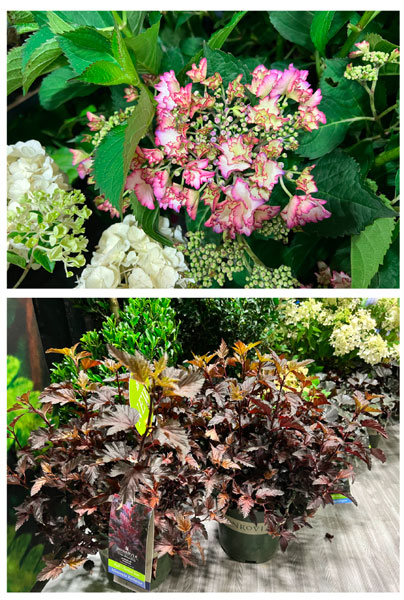
New Varieties From Monrovia
Monrovia’s booth was bursting with new and popular shrub varieties and display ideas for retail. A couple that caught our eye were:
Seaside Serenade Hydrangeas—They’re introducing two new cultivars in this macrophylla series. Crystal Cove is a lacecap type with frilly purple-blue or pink-edged blooms. But what really stood out is the new Glacier Bay, which has pure-white lacecap blooms on dark green foliage with black stems. Monrovia’s Katie Tamony calls it “a modern take on hydrangeas,” which is good because there’s lots of competition in the H. macrophylla market. Zones 4 to 9.
Another shrub we wanted to mention is Darkstar Ninebark. According to the folks at Monrovia, this ninebark has the darkest foliage on the market. The leaves start off a burgundy-chocolate color and then bronze as it matures. It stays compact and doesn’t get rangy or leggy. Zones 4 to 8. monrovia.com
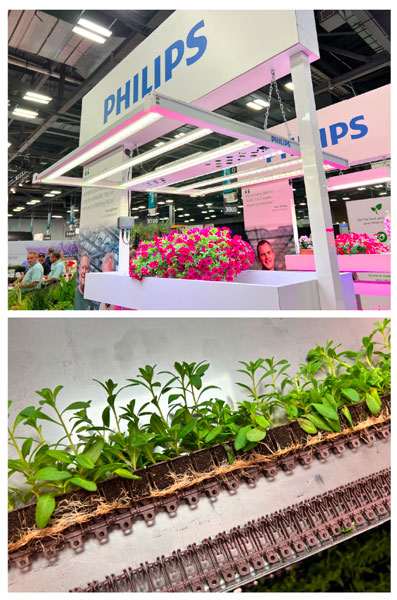
Grid Light LED
Signify/Philips, one of the leaders in horticultural LED technology, introduced the dimmable Grid Light. Measuring 44 in. x 44 in. and powered by 120 to 277 volts, the Grid Light is suitable for small or large commercial operations, vertical growing, propagation racks, even home use. An application guide, based on 15 years of research, is included.
At the opposite end of the … er … spectrum, is “The Force”—a high- powered wide-beam light designed for high-wire crops like tomatoes, cucumbers and cannabis. signify.com/en-us
AutoStix Media
If you use Visser’s AutoStix, and if you want to further speed up your young plant sticking and growing process, give their new AutoStix Media a try. Unlike regular AutoStix Strips that contain unrooted cuttings, these are pre-rooted cuttings that can run through a standard AutoStix machine. Visser has also updated the machine’s stripper bed for easier maintenance.
bellparkhorticulture.com
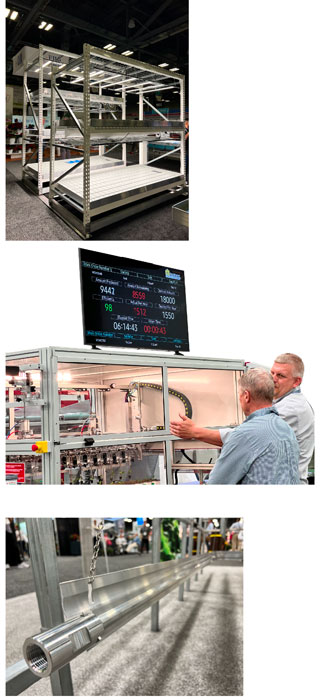
Ebb-and-Flow Benching
Ebb-and-flow bench manufacturer Innovative Growers Equipment (IGE) of Sycamore, Illinois, saw a need for high-quality, domestically produced racks for vertical growing applications. So they now design and build them, utilizing heavy-duty steel, rollers and hardware for durability in the growing environment. And, of course, they accommodate their ebb-and-flow benches.
And if growers need LEDs attached to them, IGE can provide that, too, with in-house engineered and assembled LED racks with a spectrum selected specifically for cannabis. innovativegrowersequipment.com/grow-racks-cannabis.com
Planting Scoreboard
AgriNomix’s new planting line scoreboard may have been the least expensive efficiency tool on the trade show floor. Now, we’ve seen scoreboards for sticking lines to keep track of the output of individuals, but this keeps track of the throughput of an entire transplant line, whether planting by machine or hand. It’s all wireless and cloud-based, and uses an off-the-shelf television from Best Buy or Costco or wherever.
The readout on the TV shows the current job, the desired amount, the amount produced so far and the amount remaining; the desired throughput per hour, the actual per hour and the efficiency rating; and the details of the next batch to plant. Even the line’s downtime! The hardware (minus the TV) is just $6,580 for one line; each additional line is just $1,000 more. agrinomix.com
Heat2O Heat Tubes
Stuppy Heat2O hydronic heat tubes use a new fin design with a taller top fin with more surface area (thanks to that little bend) that they say it gives off 30% more heat than a standard fin design. Also, because they can bend the fin to make 90-degree corners at the end of a bench, you don’t need leak-prone rubber hoses to make corners. stuppy.com GT